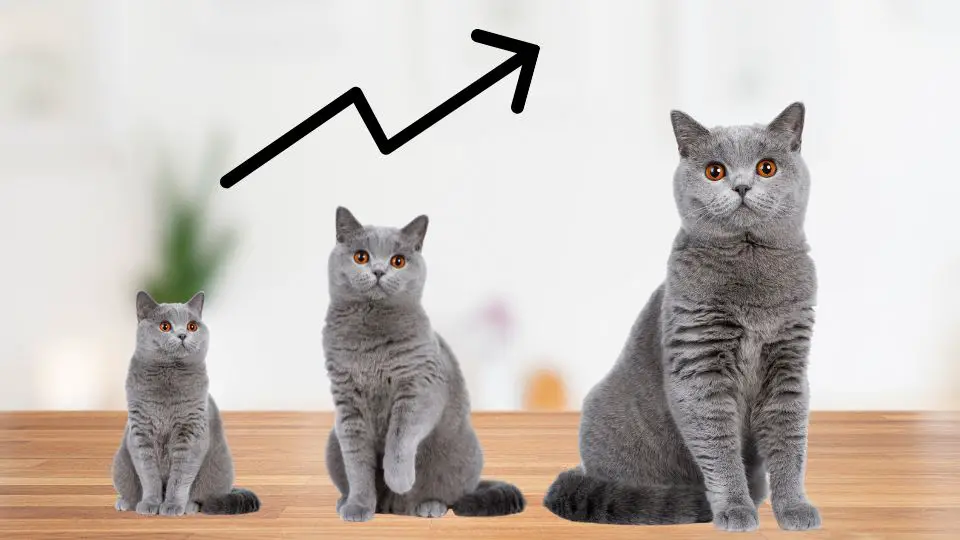Cats are known for their sharp claws, which they use for various purposes, including scratching to keep their nails healthy and mark their territory.
For many cat owners, this can lead to concerns about their furniture and other household items being damaged. British Shorthair cats are a popular breed known for their easy-going nature and affectionate personalities, but do they scratch furniture?
In this article, we will explore the scratching behavior of British Shorthair cats and provide tips on how to prevent damage to furniture while still allowing your cat to engage in this natural behavior.
Understanding Scratching Behavior in Cats
Cats have a natural instinct to scratch, which serves many purposes. When cats scratch they are stretching their muscles, sharpening their clawes and marking their territory with their scent. Scratching can also be a sign of playfulness and excitement.
Generally speaking, cats scratch in order to keep their claws healthy and sharp, but there are a number of other reasons why cats might scratch furniture.
It’s important for owners to recognize the various motivations behind their cat’s scratching behavior as well as providing appropriate outlets for it.
Can I Train My Cat Not to Scratch Furniture?
Training cats not to scratch furniture is possible but it requires patience and consistency from the owners.
The best way to train a cat is by redirecting their scratching behavior away from furniture and onto appropriate places like scratching posts. One way to make a cat switching from scratcing furniture to scratching post is to distract it with a loud noise than redirect the cat.
Owners should never use physical punishment or shouting as this could make matters worse, instead they should offer positive reinforcement for when their cat does not scratch the furniture such as treats or verbal praise.
At What Age Do Cats Start To Scratch Furniture?
The age at which cats start scratching furniture varies greatly depending on the individual cat and its environment.
Cats start scratching at about 8 months old. It is best if you start training it to not scratch right when this behaviour begins.
Most cats will reach the maturity age between 1 and 2 years. If the cat was allowed between this age to scratch, it will be hard to teach it not to do it anymore.
Do British Shorthair Cats Scratch Furniture?
British Shorthair is the least dostructiver cat breed. Kepp in mind, though, that all cats have an instinctive need to sharpen their claws so it’s important for owners of all breeds of cats, including British Shorthairs, to provide suitable alternatives such as scratching posts or mats for them.
Factors such as the age or gender of the cat can influence whether or not it scratches furniture, as can its environment – if there aren’t any suitable outlets for scratching then it may resort to using your furniture instead!
Male british shorthair cats tend to scratch more than females because they are more prone to marking territory, so you might take this into consideration when choosing your new british shorthair gender. Because scratching is a feline behavior regardless of the gender, male being more prone to scratching does not mean that females do not scratch too.
Do cats always ruin furniture?
Cats do not always ruin furniture, but it is important to remember that they have an innate need to scratch which can lead to furniture damage if their scratching behavior is not redirected onto appropriate alternatives.
Providing the right environment and training your cat correctly can help prevent furniture damage, as well as providing multiple types of textured surfaces at different heights in areas where you don’t mind the occasional mark (such as doorways). Additionally, there are products available specifically designed with cats needs in mind (such as adhesive double-sided tape) that can help deter unwanted scratching behavior if used correctly.
Other products that might help with preventing ruined furniture because of scratching are plastic or upside down vinyl carpet runner placed on furniture or carpet spots where your cat tends to scratch more.
Strategies For Preventing Furniture Scratching
- Provide appropriate scratching surfaces: Cats need to scratch to keep their nails healthy and mark their territory, so it’s important to provide them with appropriate scratching surfaces such as scratching posts or pads. Experiment with different materials to find out what your cat prefers.
- Use deterrents: There are many products available that can be used to deter cats from scratching furniture, such as sprays that smell unpleasant to cats or double-sided tape that cats don’t like the feeling of. However, it’s important to use these products carefully and as directed to avoid harming your cat.
- Cover furniture: Covering furniture with materials that cats don’t like to scratch, such as aluminum foil or double-sided tape, can also be an effective deterrent.
- Provide positive reinforcement: When your cat uses a scratching post or pad, praise them and give them a treat to reinforce this positive behavior. Over time, your cat will learn that scratching the appropriate surface is rewarded.
- Trim your cat’s nails: Keeping your cat’s nails trimmed can also help to prevent damage to furniture. This should be done regularly and carefully to avoid injuring your cat.
- Create a comfortable and stimulating environment: Cats are more likely to scratch furniture out of boredom or frustration, so it’s important to provide them with a comfortable and stimulating environment. This can include toys, perches, and hiding places to keep your cat entertained and engaged.
By providing appropriate scratching surfaces, using deterrents, providing positive reinforcement, trimming your cat’s nails, and creating a comfortable and stimulating environment, you can help prevent damage to furniture while still allowing your cat to engage in this natural behavior. Remember, with patience and consistency, you can train your cat to use appropriate scratching surfaces and avoid damaging your furniture.
Does Trimming A British Shorthair’s Nails Prevent Furniture Damage?
Trimming a British shorthair’s nails may help reduce damage caused by accidental scratching but it will not guarantee that your furniture won’t be damaged if your cat continues to use it as a scratching post!
It is still important for owners to provide adequate alternatives in order for their cat’s natural instincts to be redirected away from damaging your furnishings.
Keep in mind that it’s easier to get a kitten accostumed to clipping than an older cat. It is not impossible to start clipping an adult cat, but it might take more time to make the cat get used to it.
Conclusion
In conclusion, British Shorthair cats can have a tendency to scratch furniture if they don’t have suitable alternatives such as scratching posts or mats, altough this tendency might not be as high as in other cat breeds.
Owners who want to prevent their British shorthair from using their furniture should focus on providing suitable outlets for their cat’s natural instinct to scratch. there are strategies to prevent ruined furniture or at least make the effect smaller, such as covering the areas where the cat would scratch or trimming its claws.







